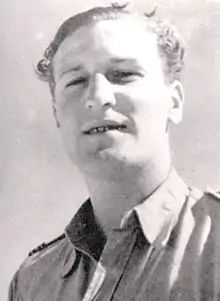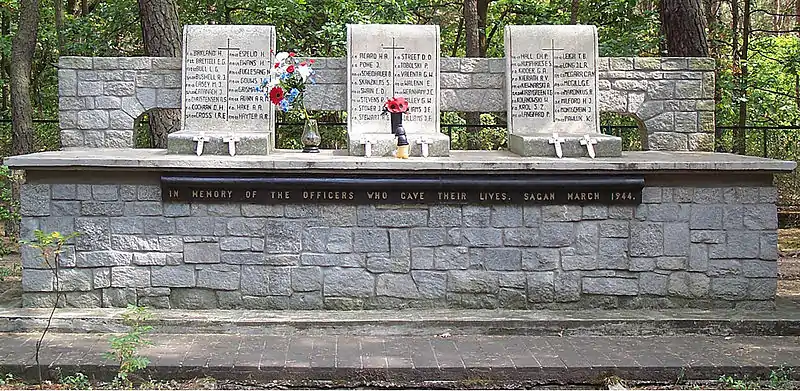John Edwin Ashley Williams | |
|---|---|
 Flight Lieutenant John Williams, c.1941–42 | |
| Nickname(s) | "Willy" |
| Born | 6 May 1919 Wellington, New Zealand |
| Died | 29 March 1944 (aged 24)[1] near Sagan, Germany |
| Allegiance | United Kingdom |
| Service/ | Royal Air Force |
| Years of service | 1938–1944 |
| Rank | Squadron Leader |
| Unit | No. 112 Squadron RAF No. 94 Squadron RAF No. 260 Squadron RAF |
| Commands held | No. 450 Squadron RAAF |
| Battles/wars | Second World War |
| Awards | Distinguished Flying Cross Mentioned in Despatches |
Squadron Leader John Edwin Ashley "Willy" Williams DFC (6 May 1919 – 29 March 1944) was an Australian air ace during the Second World War.[2] He served in the Middle East and North Africa with the Royal Air Force (RAF), and was among the Allied prisoners of war (POWs) murdered by the Gestapo following "The Great Escape" in 1944.[3] He commanded No. 450 Squadron of the Royal Australian Air Force for three days, before he was captured in 1942.
Early years
Willams, who was born to Australian parents in Wellington, New Zealand, was from Sydney.[4] According to one source, he grew up in or near the beachside suburb of Manly and was a champion surfer.[5]
Willams travelled to the United Kingdom where he joined the RAF as a pilot officer on a short service commission in 1938.[3][6]
Second World War
On 14 August 1939, Williams was promoted to acting flight lieutenant,[7] relinquishing the rank on 27 October 1939,[8] and was made a substantive flying officer on 17 August 1940.[9][10] One year later to the day, he was made a substantive flight lieutenant.[11]
On 11 April 1942, Williams received his first combat posting, when he joined No. 112 Squadron RAF, part of the Desert Air Force (DAF), flying P-40 Kittyhawks. Over the next two months, he also served with No. 94 Squadron RAF and No. 260 Squadron RAF.
Although he remained an RAF officer, Williams was redeployed to No. 450 Squadron RAAF on 14 June 1942.
During June 1942, he destroyed a Junkers Ju 87 and a Messerschmitt Bf 109 near Gambut.[4][12] On 5 July, Williams shot down a Junkers Ju 88 belonging to I Staffel/Lehrgeschwader 1. Williams scored four victories and two damaged during his time with No. 450 squadron.[13] These kills are believed to have been scored in Kittyhawk AK634 "OK-M".
In late September, Williams was awarded the Distinguished Flying Cross.[14]
During the Second Battle of El Alamein, DAF Kittyhawks played an important role, carrying out many ground attack sorties. During the battle, on 28 October 1942, Williams was promoted to Acting Squadron Leader and was appointed Commanding Officer of No. 450 Squadron. Three days later, while strafing a ground target near Buq Buq, he was shot down. Williams' aircraft was accidentally hit by fire from another member of his squadron.[15][16] He crash landed and was seen to get out of his Kittyhawk safely. The ground was too rough for aircraft to land and pick Williams up. He later became a POW.
Williams had five official victories in air combat at the time of his capture.
Death

By early 1944, Williams and another 450 Sqn officer, Flight Lieutenant Reginald "Rusty" Kierath, found themselves imprisoned at Stalag Luft III, near Sagan, Germany.
Both men were among the 76 POWs who escaped during the famous "Great Escape" in March 1944. They were both re-captured and on 29 March, along with three other Australian airmen, were among 50 Stalag Luft III POWs murdered by the Gestapo.[4][12] A posthumous Mention in Despatches was published on 8 June 1944.[17] He is buried in the Poznan Old Garrison Cemetery, which is maintained by the Commonwealth War Graves Commission.[18]
See also
Footnotes
- ↑ New Zealand Fighter pilots museum Archived 14 October 2008 at the Wayback Machine
- ↑ Australian Military Units: 40652 Squadron Leader John Edwin Ashley Williams, DFC." Australian War Memorial, 2009. Retrieved: 1 March 2009.
- 1 2 Edlington, David."The Great Crime: Aussies among Murder Victims". Archived 20 November 2007 at the Wayback Machine Air Force News, vol. 46, no. 5, 8 April 2004. Retrieved: 6 February 2008.
- 1 2 3 Herington 1954, p. 243. Note: RAAF official history, available online from the Australian War Memorial
- ↑ Sly 2003, p. 37. Note: Page is available as an online excerpt at 3squadron.org.au.
- ↑ "No. 34501". The London Gazette. 12 April 1938. p. 2458.
- ↑ "No. 34674". The London Gazette (Supplement). 8 September 1939. p. 6131.
- ↑ "No. 34822". The London Gazette. 2 April 1940. p. 1917.
- ↑ "No. 34960". The London Gazette. 4 October 1940. p. 5832.
- ↑ Australian War Memorial
- ↑ "No. 35279". The London Gazette. 19 September 1941. p. 5423.
- 1 2 Thomas 2005, p. 109.
- ↑ Thomas 2005, p. 37.
- ↑ "No. 35940". The London Gazette. 12 March 1943. p. 1246.
- ↑ Brown 2000, pp. 187–188.
- ↑ ""Comments and extracts from the diary of Viv Herrett RAAF"". Archived from the original on 5 January 2006. Retrieved 12 February 2008.
{{cite web}}: CS1 maint: bot: original URL status unknown (link). Retrieved: 5 January 2006. - ↑ "No. 36544". The London Gazette (Supplement). 2 June 1944. pp. 2613–2619.
- ↑ Casualty details — John Edwin Ashley Williams, Commonwealth War Graves Commission. Retrieved 2008-02-13
Bibliography
- Australian War Memorial, 2008, "40652 Squadron Leader John Edwin Ashley Williams, DFC"
- Brodie, Ian. 2006, "Squadron Leader John Edwin Ashley Williams". New Zealand Fighter Pilots Museum.
- Brown, Russell. Desert Warriors: Australian P-40 Pilots at War in the Middle East and North Africa, 1941–1943. Maryborough, Queensland, Australia: Banner Books, 2000. ISBN 1-875593-22-5.
- Herington, John. Second World War Volume III: Air War Against Germany and Italy, 1939–1943 (1st edition). Canberra: Australian War Memorial, 1954.
- Sly, Edward "Ted". The Luck of the Draw: Spitfires, Kittyhawks & RAAF. Ballina NSW, Australia: Spitfire Books, 2003. ISBN 0-646-46314-4.
- Thomas, Andrew. Tomahawk and Kittyhawk Aces of the RAF and Commonwealth. Oxford, UK: Osprey Publications, 2005. ISBN 978-1-84176-083-4.
External links
- Radio interview with Louise Williams detailing her discovery of the details of her uncle's career and death.